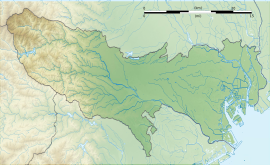Musashi Kokufu
武蔵国府跡 | |
 Musashi Provincial Capital ruins | |
| Location | Fuchū, Tokyo, Japan |
|---|---|
| Region | Kantō region |
| Coordinates | 35°40′06″N 139°28′45″E / 35.66833°N 139.47917°E |
| History | |
| Periods | Nara - Heian period |
| Site notes | |
| Public access | Yes |
The Musashi Provincial Capital ruins (武蔵国府跡, Musashi kokufu ato) is an archaeological site with the ruins of a Nara to Heian period government administrative complex located in what is now part of the city of Fuchū, Tokyo in the Kantō region of Japan. Identified as the ruins of the kokufu (provincial capital) of Musashi Province, the site has been protected as a National Historic Site from 2009.[1]
Overview
[edit]In the late Nara period, after the establishment of a centralized government under the Ritsuryō system, local rule over the provinces was standardized under a kokufu (provincial capital), and each province was divided into smaller administrative districts, known as (郡, gun, kōri), composed of 2–20 townships in 715 AD.[2] The kokufu complex contained the official residence and offices of the kokushi, the official sent from the central government as provincial governor, along with buildings housing offices concerned with general administration, farming, finance, police and military. In the periphery there was a provincial school (kokugaku), the garrison and storehouses for taxes.[3][4]
The Musashi Provincial Capital ruins are located in the Miyamachi neighborhood of Fuchū, at the edge of a cliff formed by the Tama River, with the site currently occupied by the Ōkunitama Shrine. The surrounding area contains many Kofun period remains, and from the late 7th to late 8th century, the population of an area 2.4 kilometers east-to-west by 1.2 kilometers north-to-south of this shrine had a massive population growth, with the traces of more than 4000 pit dwellings having been discovered under what is now the center of Fuchū city.[5]
Per an archaeological excavation of the shrine precincts and the surrounding area, the layout of structures corresponding to that of the semi-standardized format for a government office complex was found. The ruins consisted of the foundations for the pillars used for a two large buildings orientated east-to-west, and three buildings arranged north-to-south, with the buildings in a U-shaped orientation. Traces of moats on the south, west and north sides of these foundations indicate that they occupied a complex roughly 100 meters square, with the total complex measuring 300 meters from north to south by 200 meters from east to west. The complex was built in the first half of the 8th century and fell into ruins around the end of the 10th century. The Wamyō Ruijushō from 935 AD states only that the provincial capital of Musashi was in "Tama County" and does not give the exact location. At least five candidate sites have been considered by scholars since the Edo period; however, from the artifacts discovered, scale of the ruins, and its location on the Kōshū Kaidō highway linking Musashi with Kai Province, this site is now regarded as the correct one.[5]
Excavated artifacts include the names of 19 of the 21 Musashi counties written on tiles and rocks with a spatula, engraving, and ink. The site is about a five-minute walk from Fuchūhommachi Station on the JR East Musashino Line.[5]
See also
[edit]References
[edit]- ^ "武蔵国府跡". Cultural Heritage Online (in Japanese). Agency for Cultural Affairs. Retrieved 25 May 2020.
- ^ Shively, Donald H.; McCullough, William H. (1999). Cambridge History of Japan vol. II (p.31f.). Cambridge University Press.
- ^ Martin Schwind (1981). Das Japanische Inselreich (in German). Vol. Band 2: Kulturlandschaft, Wirtschaftsgroßmacht auf engem Raum. Berlin: de Gruyter. ISBN 3-11-008319-1.
- ^ Atsuru Yagi (March 1986), 国立歴史民俗博物館研究報告 [Bulletin of the National Museum of Japanese History] (PDF), Kokuritsu-Rekishi-Minzoku-Hakubutsukan-Kenkyū-Hōkoku = Bulletin of the National Museum of Japanese History (in Japanese) (10), p.69 国府の成立と構造 -文献史料からみた- [Formation and Structure of Kokufu (Provincial Capitals)], ISSN 0286-7400, archived from the original (PDF) on 2013-10-29
- ^ a b c Isomura, Yukio; Sakai, Hideya (2012). (国指定史跡事典) National Historic Site Encyclopedia. 学生社. ISBN 978-4311750403.(in Japanese)
External links
[edit]- Fuchū city home page (in Japanese)
- Tokyo Cultural Properties Database (in Japanese)


